Information about RADIUS
RADIUS and Switch Access
This section describes how to enable and configure RADIUS. RADIUS provides detailed accounting information
and flexible administrative control over the authentication and authorization processes.
Related Topics
Prerequisites for Configuring RADIUS, on page 57
Configuring the Switch for Local Authentication and Authorization, on page 107
SSH Servers, Integrated Clients, and Supported Versions, on page 115
RADIUS Overview
RADIUS is a distributed client/server system that secures networks against unauthorized access. RADIUS
clients run on supported Cisco routers and switches. Clients send authentication requests to a central RADIUS
server, which contains all user authentication and network service access information.
Use RADIUS in these network environments that require access security:
•
Networks with multiple-vendor access servers, each supporting RADIUS. For example, access servers
from several vendors use a single RADIUS server-based security database. In an IP-based network with
multiple vendors’ access servers, dial-in users are authenticated through a RADIUS server that has been
customized to work with the Kerberos security system.
•
Turnkey network security environments in which applications support the RADIUS protocol, such as
in an access environment that uses a smart card access control system. In one case, RADIUS has been
used with Enigma’s security cards to validates users and to grant access to network resources.
•
Networks already using RADIUS. You can add a Cisco Switch containing a RADIUS client to the
network. This might be the first step when you make a transition to a TACACS+ server. See Figure 2:
Transitioning from RADIUS to TACACS+ Services below.
•
Network in which the user must only access a single service. Using RADIUS, you can control user
access to a single host, to a single utility such as Telnet, or to the network through a protocol such as
IEEE 802.1x. For more information about this protocol, see Chapter 11, “Configuring IEEE 802.1x
Port-Based Authentication.”
•
Networks that require resource accounting. You can use RADIUS accounting independently of RADIUS
authentication or authorization. The RADIUS accounting functions allow data to be sent at the start and
end of services, showing the amount of resources (such as time, packets, bytes, and so forth) used during
Catalyst 2960-X Switch Security Configuration Guide, Cisco IOS Release 15.0(2)EX
OL-29048-01 59
Configuring RADIUS
Information about RADIUS
